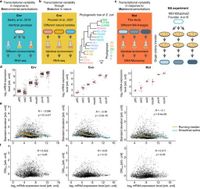Recent research has shed light on the intriguing role of gene regulatory networks in influencing phenotypic variability in Escherichia coli, a widely studied bacterium. The study suggests that both genetic and environmental factors contribute to how organisms adapt and evolve by shaping the phenotypic variants that arise when genes are expressed differently.
The study highlights that the rate and direction of phenotypic evolution aren’t solely dictated by natural selection; the availability of effective phenotypic variants induced by genetic and environmental changes plays a pivotal role. It is believed that organisms often exhibit heterogeneous phenotypic variation, with certain variants emerging more frequently than others. Researchers sought to understand this phenomenon by investigating the transcriptional variability within E. coli subjected to various environmental and genetic perturbations.
According to the authors of the article, "Our findings highlight the role of gene regulatory networks in shaping the shared phenotypic variability across different perturbations." They emphasize that this study provides insights into how organisms might respond to changing environments, which is critical for our understanding of evolutionary processes.
The backdrop of this research emphasizes that phenotypic variability can stem from both natural selection pressures and stochastic genetic changes — a dynamic widely recognized in evolutionary biology. Previous work demonstrated that variations can be induced via environmental changes which, over time, become permanent fixtures in a species' genetic makeup through a process known as genetic assimilation. However, the understanding of how these variations are systematically biased and shaped by gene regulatory networks remains less explored.
The researchers focused their analysis on well-characterized transcriptional regulatory networks in E. coli. They utilized public transcriptome datasets alongside their experimental setups to assess transcriptional responses to different perturbations. Through this comprehensive analysis, they identified significant correlations between genetic and environmental perturbations, revealing common mechanisms that bias phenotypic expression.
In a structured experiment, the team analyzed data from the PRECISE database, which encompasses various strains of E. coli, and performed mutation accumulation experiments on selected strains. This dual approach enabled them to refine the understanding of how transcriptional variability manifests under diverse conditions.
The results were telling; the analysis yielded that genes exhibiting higher transcriptional variability in response to environmental changes likewise tended to show greater sensitivity to genetic disruptions. The researchers noted that “These biases are not random but are functionally significant in coping with fluctuating environments,” accentuating the systematic nature of these adaptations.
Through principal component analysis (PCA), they illustrated that the main directions of transcriptional variation were strikingly similar across both environmental and genetic datasets. This similarity points towards an evolutionary advantage as it suggests adaptability might be steered by the same underlying genetic principles, regardless of the perturbation type.
Moreover, the study identified prominent global transcriptional regulators that coordinate changes in expression levels across genes. Thirteen of these regulators were common among various datasets tested, supporting the notion that they are integral to the mechanisms underlying transcriptional variability. Their dense regulatory networks promote resilience against diverse environmental conditions.
This research thus paves the way for a better grasp of the molecular underpinnings that facilitate adaptive evolution, proposing that the response to both genetic mutations and environmental stresses is not merely a reactive process but one deeply rooted in regulatory frameworks already built into the organism's genomic architecture.
In summary, this groundbreaking study illuminates the interconnectedness of gene regulatory networks and their function in shaping phenotypic variability in Escherichia coli. It highlights the importance of understanding these networks in evolutionary biology, pointing out that adaptations are influenced not just by the challenges posed by the environment but also by the genetic framework that organisms possess. As researchers continue to unravel the complexity of these regulatory networks, it’s clear that their role in evolution is just beginning to be understood.

